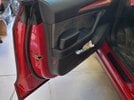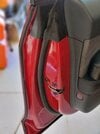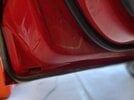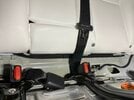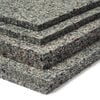Tesla Road noise; some apparent progress!
Note: I have a 2022 Tesla Model 3 Performance. Your car might have different factory build details and different places that resonate and different places that "leak" noise into the cabin.
I've been dealing with both wind and road noise. It's not as bad as some other vehicles but the wind noise can be quite annoying. And on certain road surfaces the road noise can be quite irritating as well. It can be quite loud on rough asphalt, especially at highway speeds. In this post I'm only working on the road noise. I've made other posts and lots of YouTube videos on wind noise reduction, and I've had quite a bit of success with that. But for road noise, here we go.
I applied Second Skin Damplifier Pro Mats to the rear trunk and especially around the wheel wells. I chose that brand because they are made in the USA, extremely high quality, don't smell, don't fall apart, don't melt, etc. Just good stuff. I focused upon the wheel wells and the trunk based largely upon what IloveCoffee had to say about his model Y noise. That sound deadening mat application that I did was intended to reduce mostly low-frequency vibrations and perhaps some mid range that may be set off on rough roads and may set off metal reverberations in the trunk. Large cavities are prone to be “echo chambers” and metals have vibrational resonant frequencies, so it makes sense to me to dampen that. I did not feel that such metals would be high frequency sources. I felt that the mid and higher frequency noises came in directly from other gaps such as in the doors. My application of the sound deadening mats to the trunk and wheel wells seemed to work in that it seemed to effectively dampen lower to low/mid frequencies of noise. I didn't notice much noise at all at the lower frequencies in my subjective post application test drives.
But the higher frequencies remaining seemed to be bouncing all around the cabin! And they got all of my attention now. My guess is that the lower parts of the doors were letting the tire noises in. Down near the rocker panels the tire noise must be quite loud. This is logical and somewhere I read that this is likely the case. I felt that since the Model 3 has seats and quite a bit of factory sound absorption materials in the trunk, it would be difficult for higher frequencies to be sourced from the trunk to get into the cabin.
First I did a “test”. After I was done working on trunk and wheel well dampening. I loosely placed moving blankets against the doors in the rear seats, especially at the bottom. This seemed to really make a difference. So off I went to reduce the sounds coming in through the doors.
Again, this road noise I'm working on is the roar or noise that the tires make on asphalt. It is much worse on older or rougher asphalt. I've seen long stretches of highway with this noisy surface. It is sometimes loud enough to be quite bothersome. Other times it's just annoying in the background. I'd like to improve all that.
I added a D shape rubber weather strip you can buy aftermarket. Try to get the very best. Try to buy from USA and try to ensure it has 3M adhesive. Many Chinese knock offs claim 3M but have horrible sticking power. They do not actually use 3M, they just label it so. Also, it doesn't have to be very large. Buy some smaller or moderately sized. If you get it really large, the doors won't close. Put this D shaped rubber weather stripping around the door edge, right near the outer most edge of the door. Apply these extra D shaped rubber weather stripping from the the window trim closet to the rear of the car, near the top of the door, around corners and through and along the bottom edge and stop when you meet the inner vertical door segment. There on the leading vertical edge you should use Z shape rubber, which I have only done to the driver's door so far. Only applying the D shape to both rear doors, I found a HUGE reduction in remaining higher frequency resonating cabin road noise.
Mind you, this is subjective as I don't have sensitive noise instrumentation. But wow, if I'm even close in my subjective evaluation, this is a huge return on investment.
Also worth noting. The experts strongly suggest that for road noise you must apply a heavy rubber spray on coating or add sound mats to the wheel wells. I tried that on another car, and for me it wasn't worth the mess and the very significant labor and time it took. So I figured I'd either never do it on my Tesla or save it for last.
Without doing anything to my wheel wells on my 22 Model 3, the other two things I did do, the D shape rubber and the sound deadening mats in the trunk / wheel well areas, seems I've made great progress.
Additionally, the experts say you must apply multiple layers to the metal skin inside. I did not. Again, I want to go one step at a time and test by driving and listening. I only applied a single layer of sound dampening stuck directly to the bare metal in the trunk and around the wheel wells. I did not add the suggested additional layer that supposed to work for airborne noises remaining there. I just felt that not much airborne, higher frequency noise is coming from the trunk in the model 3. For now testing seems to support my speculation.
I strongly suggest just doing two things. Once you get your wind noise under control. Then for road noise first add a D shaped rubber to the outer edge, inside the door, all around except for the leading edge vertical. Than, apply sound deadening mats on the wheel wells inside and everywhere else in the trunk (after removing the black plastic and factory mats) that seems to be noisy by testing with knuckle rapping on it.
I hope I am correct and hope this is helpful.
Note: I have a 2022 Tesla Model 3 Performance. Your car might have different factory build details and different places that resonate and different places that "leak" noise into the cabin.
I've been dealing with both wind and road noise. It's not as bad as some other vehicles but the wind noise can be quite annoying. And on certain road surfaces the road noise can be quite irritating as well. It can be quite loud on rough asphalt, especially at highway speeds. In this post I'm only working on the road noise. I've made other posts and lots of YouTube videos on wind noise reduction, and I've had quite a bit of success with that. But for road noise, here we go.
I applied Second Skin Damplifier Pro Mats to the rear trunk and especially around the wheel wells. I chose that brand because they are made in the USA, extremely high quality, don't smell, don't fall apart, don't melt, etc. Just good stuff. I focused upon the wheel wells and the trunk based largely upon what IloveCoffee had to say about his model Y noise. That sound deadening mat application that I did was intended to reduce mostly low-frequency vibrations and perhaps some mid range that may be set off on rough roads and may set off metal reverberations in the trunk. Large cavities are prone to be “echo chambers” and metals have vibrational resonant frequencies, so it makes sense to me to dampen that. I did not feel that such metals would be high frequency sources. I felt that the mid and higher frequency noises came in directly from other gaps such as in the doors. My application of the sound deadening mats to the trunk and wheel wells seemed to work in that it seemed to effectively dampen lower to low/mid frequencies of noise. I didn't notice much noise at all at the lower frequencies in my subjective post application test drives.
But the higher frequencies remaining seemed to be bouncing all around the cabin! And they got all of my attention now. My guess is that the lower parts of the doors were letting the tire noises in. Down near the rocker panels the tire noise must be quite loud. This is logical and somewhere I read that this is likely the case. I felt that since the Model 3 has seats and quite a bit of factory sound absorption materials in the trunk, it would be difficult for higher frequencies to be sourced from the trunk to get into the cabin.
First I did a “test”. After I was done working on trunk and wheel well dampening. I loosely placed moving blankets against the doors in the rear seats, especially at the bottom. This seemed to really make a difference. So off I went to reduce the sounds coming in through the doors.
Again, this road noise I'm working on is the roar or noise that the tires make on asphalt. It is much worse on older or rougher asphalt. I've seen long stretches of highway with this noisy surface. It is sometimes loud enough to be quite bothersome. Other times it's just annoying in the background. I'd like to improve all that.
I added a D shape rubber weather strip you can buy aftermarket. Try to get the very best. Try to buy from USA and try to ensure it has 3M adhesive. Many Chinese knock offs claim 3M but have horrible sticking power. They do not actually use 3M, they just label it so. Also, it doesn't have to be very large. Buy some smaller or moderately sized. If you get it really large, the doors won't close. Put this D shaped rubber weather stripping around the door edge, right near the outer most edge of the door. Apply these extra D shaped rubber weather stripping from the the window trim closet to the rear of the car, near the top of the door, around corners and through and along the bottom edge and stop when you meet the inner vertical door segment. There on the leading vertical edge you should use Z shape rubber, which I have only done to the driver's door so far. Only applying the D shape to both rear doors, I found a HUGE reduction in remaining higher frequency resonating cabin road noise.
Mind you, this is subjective as I don't have sensitive noise instrumentation. But wow, if I'm even close in my subjective evaluation, this is a huge return on investment.
Also worth noting. The experts strongly suggest that for road noise you must apply a heavy rubber spray on coating or add sound mats to the wheel wells. I tried that on another car, and for me it wasn't worth the mess and the very significant labor and time it took. So I figured I'd either never do it on my Tesla or save it for last.
Without doing anything to my wheel wells on my 22 Model 3, the other two things I did do, the D shape rubber and the sound deadening mats in the trunk / wheel well areas, seems I've made great progress.
Additionally, the experts say you must apply multiple layers to the metal skin inside. I did not. Again, I want to go one step at a time and test by driving and listening. I only applied a single layer of sound dampening stuck directly to the bare metal in the trunk and around the wheel wells. I did not add the suggested additional layer that supposed to work for airborne noises remaining there. I just felt that not much airborne, higher frequency noise is coming from the trunk in the model 3. For now testing seems to support my speculation.
I strongly suggest just doing two things. Once you get your wind noise under control. Then for road noise first add a D shaped rubber to the outer edge, inside the door, all around except for the leading edge vertical. Than, apply sound deadening mats on the wheel wells inside and everywhere else in the trunk (after removing the black plastic and factory mats) that seems to be noisy by testing with knuckle rapping on it.
I hope I am correct and hope this is helpful.
Last edited:



